Abstract
Artificial reefs featuring different shapes and functions have been deployed around the world, causing impacts on marine ecosystems. However, the approaches typically used to deliver topological complexity, flexibility and expanding requirements to prospective structures during the initial design stages are not well established. The aim of this study was to highlight the advantages and provide evidence on how modularity and parametric design can holistically leverage the performance of multifunctional artificial reefs (MFARs). In particular, the goal was to develop a parametric design for MFAR and establish a direct relationship between specific design parameters and the MFAR target functions or design requirements. The idea of implementing the parametric design for generating the initial biomimetic geometry of the individual modular unit was explored. Furthermore, possible ways of manipulating the geometric parameters of the individual module and the whole assembly were proposed. The findings suggest that, by adopting the developed procedure and the examples studied, several functions may be reached within a single assembly: the promotion of marine biodiversity restoration, the support of scientific platforms with various sensors, as well as the development of recreational diving and of touristic attraction areas. Acquired knowledge suggests that the concept of a nature-like design approach was developed for artificial reefs with varying scales, complexity and functions, which widens the range of possibilities of how smart design of human-made underwater structures may contribute to benefiting the near shore ecosystems.
1. Introduction
Artificial structures designed to attract fish, enhance surfing conditions, protect shoreline from erosion and perform other functions have been recently installed all around the world. Long term investment in artificial reef (AR) programs is perceived as important to promote the restoration of marine ecosystems and to gain more knowledge and understand the full potential outcomes of such structures worldwide [1,2,3,4] and in Europe [5]. Most of the ARs are conceived to perform single functions; therefore they are typically designed with a clear focus on a particular function and optimized to perform such a function in the best way. Among those are the ARs as discussed in [6,7], which are aimed at promoting or supporting artisanal fishery, the ones designed for coastal protection and erosion mitigation [8], others involving self-growing reticulated structures, coral-reef mimicking structures and ARs with groins, as discussed in [9,10,11,12]. In other cases, ARs are created to support recreational diving and create attraction locations [13], or for enhancing surfing conditions [11,14]. During the last decade, the concept of multi-functional artificial reefs (MFAR) have been drawing much more attention, mostly the ones taking advantage of constructed structures purposely built to perform secondary functions [15,16,17]. Additionally, MFARs are also believed to potentially yield ecological benefits, alongside other socio-economic and technical advantages [2,18]. Based on the recent past examples, there seems to exist a solid trend towards the expansion of an AR presence in coastal countries, as well as an increase in the development of multi-functional capabilities along with marine restoration [3]. The authors in [19] provided a multidisciplinary study proposing a generalized approach for designing and implementing MFARs in the Mediterranean Sea, focusing mostly on shore protection and surfing enhancing functions. Yet it is not well defined how the MFAR shape and design can influence function performance, especially if the MFAR is considered not as a standalone solution, but as part of the built coastal infrastructure.
Natural infrastructures may also be used to help coastal communities become more resilient and less sensitive to extreme events [20,21]. These are also believed to reduce the risk of coastal flooding, and the authors analyzed the strengths and weaknesses of the approach as well as the social impacts. In [22], the authors highlight past projects in the USA where traditional gray solutions suffered a shift to nature-based solutions and describe the required efforts for a successful design of the coastal infrastructure. According to [23,24,25,26], coastal nourishment structures can be, in general, classified into two major groups: gray and green. More recently other intermediate solutions were investigated and built. Regarding their shape, such infrastructures can be distinguished in a way that artificial structures typically adopt shore-parallel, regular and linear geometries, sometimes as basic solutions without a foreseen long-term contribution to the ecosystem [27,28]. Nature-inspired solutions represent a shift to the previous approach and tend to mimic or promote, e.g., dunes, mangroves and seagrass/kelp forests, providing more irregular and stochastic shapes (for example [23,24,29,30]), as shown in Figure 1.
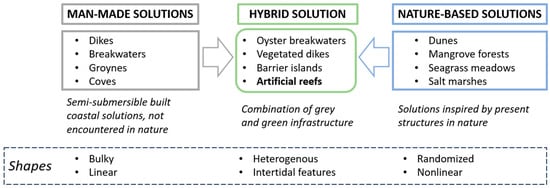
Figure 1.
Transition from a gray to a green marine shore infrastructure, adopted from [19].
The nature-inspired solutions group may be subdivided into three subgroups, namely: hybrid infrastructures, environmentally friendly gray infrastructures and soft infrastructures. However, purely naturally inspired structures, such as submerged seagrass and mangrove forests, known for their immense environmental positive impact, prove to be only partially effective for coastal protection and require appropriate measures of maintenance [31,32]. On the other hand, purely gray solutions, such as breakwaters, seawalls and dikes are installed all over around the world along with recommendations and guidelines, summarized in Appendix 3 in [23]. Such structures are commonly created without considering the appropriate conditions for biodiversity flourishing, offering poor ecological value [30,33,34]. Previous studies described the MFAR design as a relatively new green infrastructure approach, such as when MFARs are fabricated from geotextile containers, aiming at primarily surfing enhancement and additional functions such as coastal protection and biodiversity restoration [14,19,35,36]. Alternative approaches are recently attracting greater attention, based on assembling methodologies for MFAR from individual modules. These approaches are aimed at reaching wider possibilities of appearance and a greater diversity of functions, which become possible by such solutions [37,38]. Among those, the adoption of modularity brings up scalability and broader geometrical possibilities in all dimensions.
In a generic sense, MFARs seem to be excessively sophisticated concepts to be used as marine constructions. This seems even more evident when these are compared to the classical bulky, gray, monotonous and single purpose constructions that populated the recent past. The significant costs and harsh exposure conditions experienced by these structures, whether coastal, nearshore or offshore, seem difficult to justify, particularly when considering higher levels of sophistication.
Despite their promising attributes, further research should be dedicated to the fact that these structures may serve as conduits for the spread of invasive species, which may outcompete native species and disrupt local ecological balances [39]. In addition to the numerous benefits associated with artificial reefs and ways to address biotic and abiotic parameters, it is essential to consider the potential ecological risks. MFARs influence local biodiversity and may attract species not previously found in the area, potentially leading to shifts in ecosystems dynamics [40]. Moreover, these structures may serve as conduits for the spread of invasive species, which may outcompete native species and disrupt local ecological balances [41]. Additionally, by acting as ‘stepping stones’, artificial reefs may enable species to expand their ranges, leading to unintended changes in coastal habitats [42]. Another important aspect that requires further research is associated with coastal ocean energy production and extraction, as well as the role of MFARs in ocean zoning. These structures can be strategically integrated with renewable energy projects, such as offshore wind farms. This way, such structures not only support energy infrastructure but also enhance marine biodiversity by providing habitats for various marine species [41]. Moreover, MFARs can play a critical role in ocean zoning efforts by delineating areas designated for conservation, fishing, and energy production, thereby reducing conflicts between different ocean uses [43]. Furthermore, the adoption of MFARs in energy production sites can help mitigate some of the ecological disturbances associated with energy production [44]. MFARs may therefore play a relevant role in balancing ecological and industrial interests in marine environments, promoting green energy production while contributing to preserving the ocean and its essential function as the most important climate buffer of the planet in the face of climate change. However, the recent developments seem to show that these approaches are unavoidably in the path of the development needed for the coming years, as part of the next-generation systems for integrated monitoring and management of marine systems [39,40].
Still, it is not clear which design procedure of the prospective modular MFAR must be undertaken to combine several functions—for example, biodiversity restoration and coastal erosion—within one MFAR assembly. Furthermore, the adoptability of the foreseen design for specific environmental conditions, its biological presence and anthropogenic impact at the deployment zone are not sufficiently discussed yet.
1.1. Geometry and Function
The geometry is one of the most important, yet difficult to establish, characteristics of an AR. It may be determined by bioinspired features, functional requirements related to the flourishing and growth of certain organisms, aesthetics and materials. On the other hand, geometry may be strongly constrained by the requirements derived from the mechanical behavior and hydrodynamics, mostly when considering functional requirements such as the regularization of currents for sports activities enhancement such as surfing, or for the regularization of sediments transit, among many other functions. In order to provide some of the requirements for AR shape design, a brief overview is provided explaining the link between AR shape and expected function.
1.1.1. Fisheries and Biodiversity Restoration
There are numerous planned and existing artificial structures that are aimed at increasing the marine species diversity and biomass in coastal regions. In [41], the author discusses the key attributes to achieve by a reef design aimed at promoting fisheries and biodiversity restoration:
- Topology—AR topology should aim at creating spatial diversity and protection from strong water movements;
- Articulation—Spatial arrangement and structural complexity should be achieved in order to provide a range of habitats and guarantee protection from predators;
- Texture—The substrate materials and surface finish should be adequate for sessile (stationary) organisms attachment.
This approach was implemented among a wide range of research projects and proved to work at different scales [37,42,43] targeting specific species, either fish [44,45,46] or corals (for example [47,48]), and creating structures with sophisticated attributes for ecosystems regeneration [46,49].
1.1.2. Coastal Erosion and Surfing Enhancement
Coastal erosion prevention is a challenging task for many coastal populations due to global sea level rise and harsh weather conditions. In some cases, it is the occupation by human activities of areas close to the coast that has been highlighted as one of the main reasons justifying accelerated coastal erosion [25]. Conventional solutions include traditional bulky foreshore (breakwaters, groynes, and jetties) and onshore structures (seawalls, revetments and sea dikes), which may be considered as gray infrastructures, as previously discussed. In addition, there are other solutions offered by green infrastructures, which are aimed at performing similar tasks with better ecosystem impact [34]. Coastal preservation infrastructures combining green and gray approaches are arranged in three types: built (seawalls, levees, and bulkheads), natural (salt marsh, beach, etc.) and hybrid (combination of built and natural). Each of these has a list of advantages and disadvantages, as discussed by the authors in [50]. Depending on the arrangements and options taken, some related to cultural factors of coastal communities, the designs of the preventive measures are drastically different. Returning to the AR concept, it is common for bulky submerged structures to perform two functions simultaneously, namely coastal protection and surfing enhancement. As discussed in [51], such structures are most frequently created by employing sand-filled geotextile containers (see Figure 2a) or by piling up rock masses in situ, occupying relatively large spaces as high as 60,000 m3, typically exhibiting boomerang-shaped/V-shaped reefs/horseshoes at an orientation with the sharp end to the offshore direction with respect to the principal wave direction, as shown in Figure 2b.
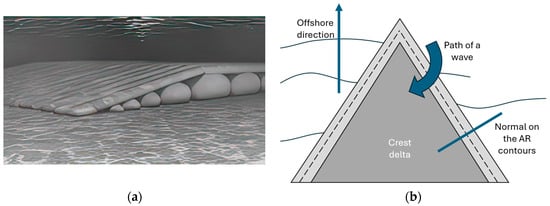
Figure 2.
(a) Typical geotextile AR installation geometry, adopted from [52]; (b) schematic view of the AR designated for coastal protection and surf enhancement, adopted from [51].
1.1.3. Tourism Attraction
Recent initiatives toward the deployment of AR have been aimed at creating jobs and enhancing local economies, pursuing tourism presence enhancement as well as ecosystem conservation goals. These AR designs have been greatly influenced by the motivations of recreational divers, who prefer to dive where “the chance of viewing concentrated marine life, increased photographic opportunities, and the guarantee of a ‘good dive’ are provided. In addition, divers express significant concern toward the pressure created in natural reefs as a result of intensive diving activity. The possibility of using ARs for providing alternative habitats for marine organisms, and creating alternative attraction spots for diving, constitutes an effective indirect protection measure for particularly sensitive natural reefs and habitats, which should be kept off the frenzy of intensive recreational diving [53]. From the viewpoint of design, typically such structures are materialized by shipwrecks [54,55], underwater artistic sculptures [56] and sometimes by using additional acoustic equipment [57]. Summarizing, ARs optimal characteristics for tourism attraction include significantly large scale and geometry, and unusual features that resemble the natural ones found underwater.
1.1.4. Artificial Reef Geometry–Function Relationship
In order to provide better insight into the relationship between an AR shape and its targeted functions, as well as for future referencing, in Figure 3 the different design approaches found in the literature are classified according to a newly proposed approach. This approach considers that there are three main groups of functions for ARs, which may typically lead to antagonistic designs. For example, structures optimized for coastal defense may privilege heavy and bulky units that may be exposed to sediment deposition, while reefs designed with the aim of propitiating biological colonization should not be exposed to the same type of sediment deposition, since it threatens sessile communities and settlement. The three main groups of typically antagonistic functions may be considered as: (i) fisheries and biodiversity restoration, (ii) recreational diving and tourism attractions, and (iii) coastal erosion and surfing enhancement. Considering the predominantly opposed characteristics of these three main groups of functions, they occupy opposite corners of this triangle, although in special cases, synergies between these different groups may be found. Additional levels may be added to subgroups of functions, since these are quite broad, although the concept is the same.
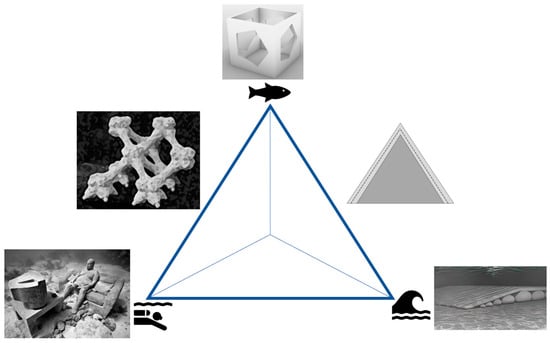
Figure 3.
Representation of the existing AR shape in relation to the potential function: lower left corner—recreational diving and tourism attraction; upper corner—fisheries and biodiversity restoration; lower right corner—coastal erosion and surfing enhancement.
In corners of the triangle, snapshots of typical structures are delivered from already existing projects. It should be remarked that references that discuss ARs with a single function or a single purpose tend to be located near the respective corner, belonging to the main functional group. Meanwhile, ARs that simultaneously perform two or more functions are located at the intermediate space within the triangle in agreement with the potential functions. For example, underwater monument parks, discussed in [56], are dedicated solely for recreational tourism, and therefore they do not either create an optimal habitat or prevent erosion; therefore, it seems reasonable to locate it next to the corner of the ‘Recreational diving and tourism attraction’. However, another example is found in [19], where the MFAR was designed with the aim of contributing to at least two functions—‘coastal protection’/‘surfing enhancement’—while supporting the local biodiversity. Since the design process did not consider the development of characteristics considered as attractive for diving, which may actually be considered as incompatible with surfing or coastal protection functions, this design occupies a position in the triangle that is halfway between the ‘biodiversity restoration’ and the ‘surfing enhancement’ functions, while standing far from the ‘recreational diving’ function.
1.2. Deployment Area
One possible way to test the efficiency of the MFAR is to simulate the behavior of the proposed design and concept at prospective specific deployment locations. For this, a well-described Marine Protected Area (MPA), the Littoral North Marine Park in Esposende, Portugal was considered in this study. The abundance of the environmental, biological and cultural information in this MPA allows us to analyze the potential of installing an AR structure and function. The biota data provides evidence of several species present in the area, for example sea kelp (Laminaria hyperborean), red seaweed (Dilsea carnosa, Kallymenia reniformis, Chondrus crispus, Plocamium cartilagineum and Corallina officinalis), starfish (Asterias rubens and Marthasterias glacialis), and sea urchins (Echinus esculentus), along with wrasse (Ctenolabrus rupestris, Labrus bergylta, Symphodus bailloni, Coris julis and Centrolabrus exoletus) and blennies (Parablennius pilicornis and Parablennius gattorugine). Some crustaceans are present as well, for example lobster (Hommarus gammarus), velvet and spider crabs and molluscs (particularly Octopus vulgaris). In accordance with the MPA management plan, among priority species for the conservation is white seabream (Diplodus vulgaris) and European bass (Dicentrarchus labrax). Additionally, this MPA is a local attraction for recreational divers due to the close proximity of shipwrecks and underwater natural heritage locations. Finally, due to a strong exposure to waves, erosion is severely impacting the beaches and imposing morphological changes.
Considering this, it may be beneficial to the MPA to develop a MFAR system that may efficiently perform functions associated with ecosystem restoration, tourism attraction and erosion mitigation, based on a functional unit and adopting nature-based coastal infrastructure principles.
1.3. Design Process and Biomimicking
Keeping in mind previous considerations for the AR design for a specific purpose, the next step is to establish the initial design of the MFAR. For this, biomimicking principles adopt, to a certain extent, the natural substrate shapes and topologies, as described in [58]. The biomimicking approach is important for the MFAR and pursues features that are similar to the ones found in the surrounding natural reefs, which were created by natural processes [13,59,60]. Such natural reefs exhibit the surface and bulk features that are favorable for the local organisms, thus elevating the importance of guaranteeing micro and macro topology complexity of the MFAR similar to natural rocky reefs; see Figure 4.
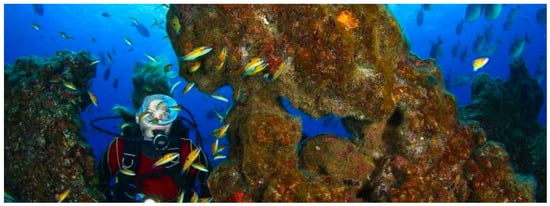
Figure 4.
Large scale underwater rocky formations at the MPA close to Esposende, Portugal.
Considering that there is still a lack of objective and well-defined design procedures that relate requirements with the design parameters of ARs, this research is dedicated to contributing to the development of alternative design approaches. The goal is to approximate the design process based on a set of parameters and the MFAR requirements, to improve the MFAR design and obtain the required performance in several functions within one structure. Furthermore, the main goal was to pursue a parametric design approach for MFAR where specific design parameters may be directly related to MFAR target functions and design requirements. Parametric design adoption for conceiving and replicating natural features is discussed in Section 2. The analysis of the obtained workflow, delivered assemblies and created prototypes, rethinking, and provided results are disclosed in Section 3. The peculiarities of the designs obtained are analyzed and discussed, as well as the typical geometry and shape definition criteria adopted in Section 4.
2. Materials and Methods
2.1. Parametric Design-Based Approach
The historic approach to ARs around the world has been based on the use of scrap material: decommissioning ships and oil rigs, piling tires, dumping vehicles and other waste products [55,61,62,63,64]. The proposed MFAR design methodology implies combining the previously mentioned functions for ARs in terms of shape, size and other features in a rational procedure that allows for utilizing the prospective structures with maximum efficiency. In order to apply this methodology, the design workflow and the steps that need to be undertaken from the concept until the prototype is reached, need to be established.
For this, a set of rules and references for regulating the geometry of a single unit and unit arrangement was adopted. The purpose was to create a limitless number of morphologically different versions of the final unit design. Such an approach following the parametric design approach [65] was adopted.
Parametric design is opposed to conventional CAD design in that the shape should not be conceived beforehand. Instead, the shape should evolve as result of the data/parameters applied, and later the resulting form can be modified and adapted in a new iteration with the next set of algorithms. The output shape of the unit or assembly developed with a parametric design is then translated into the required format for subsequent manufacturing, for example G-code. This format is then used for computer aided manufacturing processes, for example using conventional 3D printing methods using plastic materials [66], or using clay or ceramic materials [60,67]. Parametric design allows for a reflexive design process, and unlike traditional design methods, it allows mass customization at a convenient and faster level. It allows a dynamic and responsive design process that can be tailored in a holistic way to specific environmental conditions and requirements. By scripting design intent into computational models, parametric design facilitates iterative exploration, optimization, and customization, fostering innovation and efficiency in the design process.
Furthermore, another advantage of employing this approach is the sustainability factor that implies optimizing the material usage as well as ecological integration into the ecosystem by fostering symbiotic relationships between artificial structures and native marine ecosystems. Ultimately, parametrically designed MFARs may also allow dedicated studies to identify the relationship between design parameters of the parametric design and the ecological response generated, opening up new perspectives for the development of rational procedures for MFAR requirements-oriented design methods.
Rhino3D® version 6 software with Grasshopper® plug-in was used as the main tool for conception and geometric design of the MFAR unit, as these employ visual programming tools for parametric designing approaches [60]. The use of these conception and design tools for the achievement of various rules for constructing shapes and geometries of diverse complexity and maturity is considered as the most promising, considering the large user communities. Additionally, the ability of the software to export the created computer models for additive manufacturing benefits the subsequent rapid prototyping.
Each unit in this concept consists of a parametrically designed part, which starts as a sphere and multiple tubes that emerge from the sphere surface and have the blind end at a surface parallel to one face of a virtual cube. The main part of the concept relies on this shape and the dimensions of the central sphere. Each tube is designed using parametric computational tools and may vary from one case to another, considering biomimicking principles and the requirements of the marine structures, e.g., stiffness, robustness and environmental compatibility. This brings the flexibility required to the structural design of the final AR, which is of extreme importance due to the nature of the seabed properties—inhomogeneity, sand/rock structure, variable bathymetry etc. In addition, the possible functions of the AR may comprehend marine biodiversity restoration, shore protection, self-monitoring, environmental monitoring, and other secondary functions. In other words, the constructed system will comply with the requirements of a MFAR ready to combine the highest number of potential functions, serving as an underwater complex system.
There are a few strict requirements to accomplish the prospective structure of the AR. To define the geometries, the most relevant requirements considered in the design of the structural module or unit are subsequently summarized:
- Adoption of a natural reef mimicking shape: natural marine habitats adopt topologies that are determined by environmental exposure conditions, as well as organisms’ growth at the micro and macro level. These are optimal for specific flora and fauna species at different levels of the food chain, exhibiting structural complexity typical of natural habitats [68];
- Various assembly possibilities and macro-arrangements: this is achieved by introducing modular construction, which offers a wider range of structural possibilities based on a limited number of units, optimizing costs and resources. These become of great importance when local effects are taken into account, e.g., the bathymetry profile, organisms’ diversity, currents and wave principal directions, and AR dimensions, among others;
- Expanded AR functions: technological and engineered ARs may offer other possibilities to secure a wider set of functions that an AR can perform, based on the embedment of systems and networks that conventional gray infrastructures do not include. Examples are energy sources, interconnected electric and electronic networks and sensors. These enhance taking advantage of the huge resources typically allocated to build an AR, contributing to a wider range of functions aimed at marine ecosystems restoration [19];
- Semi-permeable structure: unlike the massive coastal protection structures described previously, the final geometry is required to be reticulated, geometrically complex and spatially distributed, maintaining the requirement of biomimicking, while guaranteeing benefits for direct or indirect erosion prevention (example: the creation of AR barriers, discussed in Section 3.4);
- Attractive to tourists, recreational divers and local communities: in order to generate interest from divers and tourists, the geometry and other AR features are required to guarantee appealing features not only to marine biodiversity but also to the human population;
- Iterative design sequence: after the starting stage of delivering the initial shape, prototyping and testing follows. The analysis of the results obtained after the preliminary testing of the initial shape results in a series of additional design features to be implemented, which are reconsidered and possibly implemented. Then, a new stage of prototyping and testing follows, until the optimal design of the MFAR is assumed as properly satisfying the current design and application requirements.
Subsequent stages of this study will include the development of advanced manufacturing processes that make possible some of the most complex geometries developed. Responding to the requirements mentioned previously, the steps that have been followed as part of the design procedure are described subsequently.
2.2. Design Procedures and Variable
An initial inspiration for defining the biomimetic design of the MFAR was taken from the natural shapes and features of a coral reef branch, following the concept of biomimicking, as shown in Figure 5a. At a larger scale, also the shapes of reefs and rocky substrates as well as small caverns have been considered, as these natural shapes and features may constitute appealing characteristics to organisms. The first design of the module was made departing from a virtual cube, which represents the maximum occupied space of one unit in a 3D array of other units. Furthermore, each unit should have at least one rigid connection with other neighboring units, which results in a maximum number of six connections according to the number of cube faces, granting the ability of the AR anatomy to perform as a modular structure. However, another option taken in the design was to restrict the number of connecting faces to three in order to simplify its structure. Afterward, one of the faces was chosen to have dual connection points. The two other faces had only a single connection point. Each single connection point was located at the geometrical center of a cube face in order to allow the connection between units at different rotation angles.
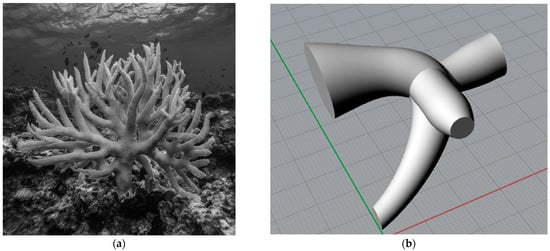
Figure 5.
(a) Coral branch, used as an inspiration for the macro- and micro-structural features design of the future unit and MFAR design, (b) pilot design of the MFAR modular unit.
Another typical characteristic of natural structures and reefs is the complex distribution of features, scales, textures and properties. The “complexity” characteristic that is typical of natural structures was explored in the current design in different ways, one of those at the level of the unit, by defining random locations for the dual connection points of the unit when picking the respective cube face. After defining the location of the connection points between neighboring units, the tubes were designed and connected at the geometrical center of the cube. Dual connection points offer higher variability of AR assemblages as they allow two units at one face of the cube to join, while single connection points support only one connection to another neighboring unit at one of the cube faces.
After establishing the basic rules and parameters of the reef design to be developed, subsequent advancements of the structural design details were performed using the parametric features and visual programming of Rhino3D® and Grasshopper® tools. These advancements included the study of several variables following the parametric design principle, including the change of curvature levels, the variation of pipes radii and the altering of the positioning of the dual connection points, as well as other features aimed at changing the surface roughness and features properties. At the end of this process, a pilot design for the unit was delivered, as shown in Figure 5b.
The pilot design of the module had several imperfections, among those the anticipated problems in concrete casting and demolding of the units, as well as the obvious weaknesses in terms of stiffness of the overall assembled structure. In addition, it was decided that the connecting faces of the unit should assume the same size and cross-section geometry to allow for seamless connections between units at varying rotational angles considering the axis of rotation as the one perpendicular to the connection surface. This feature was expected to allow more geometrical variability of the AR arrangement. After slightly varying the radii of the joining faces and adding a sphere shape located at the geometrical center of the cube, another alternative initial design of the unit was obtained, as shown in Figure 6a.
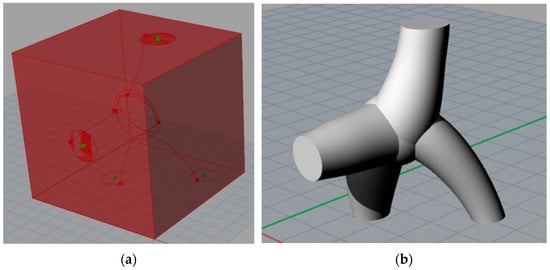
Figure 6.
MFAR module design depiction: (a) base skeleton of the geometry with connection points (green crosses) where curves depict the curvature of tubes and the circle in the center depicts the sphere geometry; (b) module geometry prepared for subsequent prototyping.
As a demonstration of the parametric design approach and its flexibility when applied to the MFAR design, the following example is provided in Figure 7. The provided case serves a representation of the parametric design capabilities applied to the MFAR design and does not represent the finalized engineering design; therefore, functional elements such as connectors between units, manufacturing material and method of fabrication are not included. The structure (a) consists of four units, shown in Figure 6b, interconnected in a manner that all tubes, except the double connection ones, are mutually connected. The sliding “index” parameters (variables) shown in the visual programming graphic interface, at the bottom right, are related to the initial position of the double tube at the surface of the virtual box. The top and bottom indexes are related to the position of the first and the second tube, respectively. By varying both indexes by simply sliding the bar, the double tube position changes appropriately at every location where the unit is involved, as shown in Figure 7b,c. This example is replicable to any other of the 60 variables used to describe the developed model, including the number of pieces and module arrangements, which allow for modifying the unit shape, the micro- and macro- overall arrangement, as well as the surface properties of the modular MFAR in a rapid and very interactive fashion.
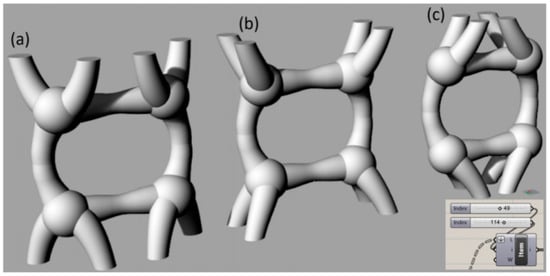
Figure 7.
Variations of the geometry made possible by the parametric design approach of the modular AR: (a) initial arrangement of four modules, (b,c) same arrangement but changed by only manipulating a double tube end location index in the graphical interface of the parametric design software (bottom right).
Aiming at adding more features for better performance of the structure in terms of marine colonization, parametric design tools offer the possibility of surface refinement adding topology such as cavities and fissures, regarded as creating micro-level complexity. These features are typically encountered among the living corals and other natural reefs. An example of the enhanced topology is shown in Figure 8a, which was created by introducing Boolean operations with spherical and toroid objects, interpolated curves, and randomly distributed geometries on the initial unit geometry. Such modification allows the individual structural unit to perform as an effective AR, adaptable to the preferences and behaviors of particular fish species or other organisms by replicating their natural habitat condition [41,42,69,70]. Furthermore, as indicated in [71,72], coral larvae are more likely to settle on substrates that have millimeter-scale ridges. This suggests that larvae prefer surfaces with textures that match their size, maximizing the number of attachment points and thus increasing settlement success. Coral larvae exhibit a preference for these microtopographies even in the absence of chemical cues, indicating the crucial role of physical structure in their settlement behavior. Additionally, fractal and complex surface structures provide various microhabitats and attachment points that can support larger and more diverse gorgonian populations. Habitat heterogeneity, driven by factors such as reef complexity and topographical variations, has been shown to enhance the biodiversity and resilience of marine ecosystems [73,74]. This provides a clue as to how generic data from biotic parameters such as fish, larvae and gorgonians settlement enhancement can be adopted to the MFAR micro and macro topology using parametric design tools. Similar to the case represented in Figure 7, the designs depicted show the potential of parametric design tools for this purpose, while omitting the fabrication process and associated engineering considerations such as final dimensions, mass and material properties.
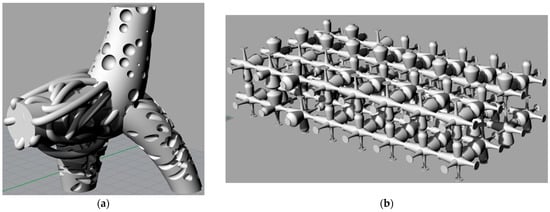
Figure 8.
Possibilities of parametric programming when applied to the design of modular AR: (a) surface refinement of the AR unit using Boolean operations with various geometries and (b) randomly mutually oriented and distributed three-dimensional array of a module.
3. Results
3.1. First MFAR Unit and Assembly Prototyping
By employing the initial geometry of the unit (see Figure 6b), a wide range of MFAR assemblies were reached. One of those assemblies is presented in Figure 9a, which is formed simply by manipulating mutual connections of the unit at different levels. Another option for the MFAR assembly, involving the same geometry for the unit but adding the surface refinement and tackling the mutual arrangement, resulted in the structure shown in Figure 9b. This virtual model meets the requirements mentioned in Section 1.3; for example, it shows an organic and somehow mimicking shape resembling natural structures, such as the ones shown previously. The AR arrangement achieved features with several other functions, such as: (i) parametrized micro- and macro- geometrical features, allowing it to embody different complexities at different scales aimed at marine restoration; (ii) optimal locations for the installation of structural and environmental monitoring (SHM) systems, as discussed in [75,76,77]; (iii) visually appealing configurations from the viewpoint of recreational diving [78], and (iv) by installing electromechanical system in joints between units performing as an energy harvesting system [79,80]. The MFAR final design is anticipated to encompass five functions within the same structure, created by handling the individual unit and considering specific approaches to design and assemble these systems.
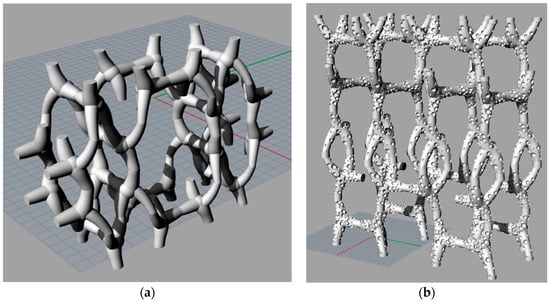
Figure 9.
MFAR arrangements with only one type of module: (a) reticulated and (b) vertically expanded with additional surface refinement.
The first prototype was delivered considering the development of subsequent studies in a water flume, with a cube edge of 50 mm. Later, the 3D model of the unit was imported to the printing software and fabricated using an additive manufacturing 3D Fused Deposition Modeling approach, using a thermoplastic filament widely used in marine applications for making the natural-like shapes of living habitats [66]. The fabricated pieces are shown in Figure 10a, and were later used as a matrix for creating the silicon molds for casting the concrete prototypes. The purpose of the produced pieces was to create assemblies of the prospective AR and do a first assessment of the variability of the AR arrangements. After casting all units, the resulting set of units (see Figure 10b) was connected in order to produce the prospective MFAR assembly, shown in Figure 10c with approximately 250 mm height and 220 mm width, similar to the model geometry shown in Figure 9b. One can notice that, due to imperfections during the concrete casting process, small cavities are present, which could well be assumed as an advantage and an added surface topology feature, which at large scale can perform as shelters in case these persist in the real scale size units after fabrication.

Figure 10.
Prototyping the previously designed modules: (a) module prototype created using additive manufacturing and plastic; (b) module cast using concrete; (c) glued arrangement involving concrete parts, submerged in water.
3.2. Second MFAR Prototyping
After analyzing the results obtained at the end of the first prototyping stage, a slightly different approach was used, aiming at creating a higher level of complexity compared to the first MFAR prototype. The geometry of one unit was mirrored with respect to one of the virtual box planes to create a joint of two modules. In addition, to enhance the structural integrity, the radius of the central sphere was increased; see Figure 11a,b.


Figure 11.
Virtual representation of MFAR arrangement involving the modified geometry of the units: (a) increased sphere radius at the center of the module structure; (b) mirrored pieces joint; (c) MFAR arrangements offered by two types of module geometries—initial and mirrored, enumeration is explained in the text; divers are approximately 1.8 m tall, provided for the sake of scale.
The resulting assemblies, including the modified geometries, are shown in Figure 11c, where:
- Assembly (1): consists of a two levels arrangement, depicting a parallelogram shape in the horizontal plane;
- Assembly (2): is essentially similar to assembly (1), but two additional modules have been included at the top of the two base levels, increasing the niche volume and complexity with just a couple of additional units;
- Assembly (3): consists of an arrangement that was optimized for divers to be able to enter the structure and navigate through it, like a cavity or a square “window”;
- Assembly (4): represents the arrangement of a reticulated and vertically expanded structure, which in a horizontal projection has a circular shape; this arrangement maximizes the 3D sheltering effect while still allowing for easy diver access. It may also induce upwelling effects and change sediment settling, as found in preliminary studies carried out with prototypes in a hydraulic flume, described in [81,82].
Preliminary studies on both the structural behavior and on the effect of hydrodynamic actions on the reef conceptual design have resulted in reasonable safety factors and revealed the weakest structural regions, as well as possible failure mechanisms [83]. Furthermore, structures (2, 4) are somewhat expanded in the vertical direction, and have a difficult in situ assembly process by simple means and from the available modules. Finally, structure (1) performs all required functions discussed above; therefore, it was chosen for the prototyping. In Figure 12a, a zoomed look on the structural assembly is shown.
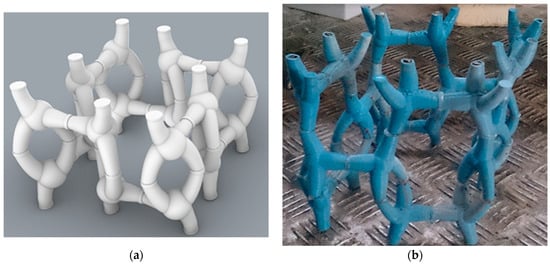
Figure 12.
MFAR arrangement involving the modified module geometry: visual presentation of the MFAR with optimal modular structure (a); prototype of the MFAR assembled from two types of modular pieces (b).
3.3. Modifiable Parameters of the Digital Design Model
The number and variations of the modular parts in the MFAR lie in a vast range of parameters of each unit and the prospective location of the instalment; therefore, this number may vary between 2 and unlimited.
As shown in Section 2.1, by simply manipulating the parameters of the parametric model, the shape, topology and assemblies can vary drastically within quite a large scale, allowing for the creation of rather flexible solutions of module geometries. This can be demonstrated by updating the previously mentioned Figure 3 that the proposed system belongs to a region that lies in a cloud of available shapes in the middle of the triangle, where the arrow points at the developed MFAR system; see Figure 13. It is worth noting that based on the literature review conducted and to the best of the authors’ knowledge, examples with potential shape features that may be related to the bottom region of the triangle, between the “Recreational diving” and “Coastal erosion”, are nonexistent.
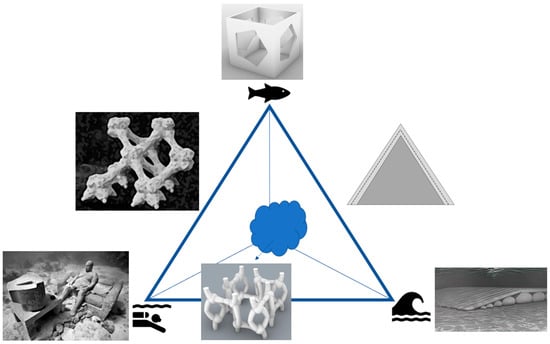
Figure 13.
Representation of the existing AR and proposed MFAR shape in relation to the potential function.
After careful consideration, all functions of the prospective underwater system unit, as well as how the MFAR structure can support such functions, are summarized in Table 1.

Table 1.
Functions of the MFAR and means to support it.
3.4. Application of the Designed MFAR within the MPA
As indicated in Section 1.2, the MFAR design/deployment site is an MPA. In this case, one location in Esposende, Portugal was hypothesized. An effective interaction of the MFAR with the marine environment would be based on guaranteeing the MFAR required functions to be in place. This can be achieved through several ways, divided in the following discussion into three groups.
Initially, the fishery and biodiversity restoration functions may be achieved by adapting the MFAR geometry for species that are present at the MFAR deployment zone. Cavities and caves, which may be parametrically designed within the MFAR structure as surface refinements at the smaller scale, such as the ones shown in Figure 8a and Figure 9b, are preferred by mollusks and crustaceans, which mostly choose closed spaces within AR structures [84] and foundations [85]. The populations of fish considered for commercial exploitation such as seabass may be promoted by introducing the turtle-shaped MFAR unit arrangement, as discussed in [86]. One of the possible unit arrangements and beneficial effects for fisheries promotion associated with the proposed MFAR structure-induced flow transformation is described in detail by [87]. By exposing the MFAR structure to an incoming flow that is typical of the deployment location, significant upwelling and wake regions are formed, thus providing the optimal feeding and habitat conditions for target fish species. Such an MFAR structure may be installed within a single AR project or in the framework of the coastal infrastructure taking into account specific biotic or abiotic treatments offered by the MFAR concept, as discussed in Table 2.

Table 2.
Overview of biotic and abiotic parameters to be considered in the parametric design.
Secondly, an extension of the modular and parametric concept studied and developed can be applied to the design of larger-scale structures. For example, a reef barrier along the shoreline, which can be integrated into the hybrid or green coastal infrastructure, can address the problem of erosion and scour in the MPA associated with the wave action. Other authors have shown its effectiveness in shoreline contexts [23,28,42,88]. In order to create an expanded MFAR system using the designed units and the modular approach previously described, a parametric design was used to produce the repetitive modules in the horizontal direction, thus establishing what could be regarded as a reef “barrier”, resulting in a MFAR assembly of several full-scale smaller MFAR units to perform as a shore protection mechanism, among all of the other functions previously discussed. By employing the MFAR assembly (2) from Figure 12a and joining several similar mono-MFARs along one line with pairs of mirrored unit connections, the digital model of the expanded MFAR system was obtained; see Figure 14. In the context of the MFAR “barrier” concept, no further investigation was performed in terms of materials, structural durability, or hydrodynamic interaction. However, the estimation of the long-term environmental behavior and effect on the environment are regarded as very relevant future studies.

Figure 14.
Reef barrier parametrically designed and assembled from the multiple MFARs with connecting nodes.
On the other hand, while parametric design offers significant advantages for singular MFAR and MFAR barrier development, several challenges remain to be addressed. These include the need to combine interdisciplinary collaborations among designers, marine biologists, ecologists and engineers in order to establish the relationships between the parametric design variables and the outcomes in terms of environmental effects and impacts obtained. The development of robust monitoring and evaluation frameworks to assess the long-term performance of parametrically designed reef structures is also relevant.
Finally, recreational divers are typically present in the MPA and are found visiting underwater natural heritages with a variety of biota, archeological artifacts and shipwrecks, or looking for new experiences. Therefore, the presence of a biomimetic structure that may be colonized in a similar way as rocky reefs native to the MPA zone may provide a new AR-based tool oriented to improve the diving experience and promote the presence of recreational divers in controlled areas. This may benefit the MPA zone by enhancing the local economy and eventually protecting other sensitive areas from the divers by promoting attraction spots in the MPA at distant locations from sensitive areas [89,90].
3.5. Performance Indicators
Section 1.1.1 provides the geometrical features of an AR designed for fisheries and biodiversity restoration. However, it is important to understand how the decisions with regards to the different design variables impact the successful performance of an AR. For this, one important process in the design stage is to conduct a comprehensive Computational Fluid Dynamics (CFD) analysis in order to evaluate the effectiveness of an AR design for promoting the required flow interactions by evaluating the upwelling and wake region volumes, such as proposed by [91,92]. The volume of wake and upwelling regions for a modular artificial reef were assessed and discussed by [87]. However, a comprehensive CFD study of various complex shaped MFAR designs may pose a significant computational challenge, being time consuming and complex. The decision support in the design stage needs to adopt an alternative approach, which should allow the designer to make decisions about the application requirements based on analytical calculations.
Structural complexity may be one of the variables aiding in the design process, and the calculation of the complexity index (SI) is proposed in this study. According to the formulations proposed by [93], the SI index is computed according to Equation (1):
where is the total surface area of the MFAR with all surface cavities and refinements, and is the bottom projection area that is evaluated as the projection of the entire structure on the base plane; see Figure 15.
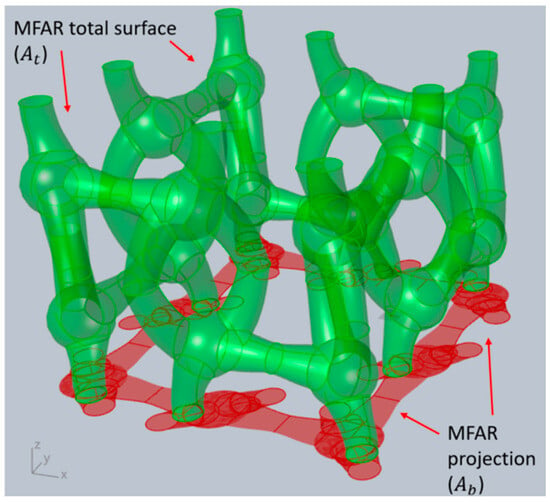
Figure 15.
MFAR total surface area and projection area.
Parametric design is particularly useful for iteratively computing the total surface of the MFAR using a single operation, as well as further optimization. On the other hand, the bottom projection area represents the rectangular area occupied by the MFAR, as suggested by [93,94], obtained by the vertical projection at the base plane. In the present research, the vertical projection of the 3D shape at the base plane of the entire MFAR structure is a complex shape (see Figure 15); therefore, is proposed to represent this projection on the base plane, as shown in the red shape in Figure 15.
As discussed in Section 3.3, the digital model of the delivered MFAR can be modified in various ways, including the surface refinement. Such surface refinement can be based on creating nest cavities that vary in dimensions and target the restoration of specific species and habitats of the ecosystem at the prospective deployment location [95,96]. Furthermore, the refinement elements will impact the SI values since the total surface and bottom projection areas may change accordingly. In order to replicate nest cavities of different sizes and evaluate their impact on the final SI, a surface refinement approach was analyzed. First, 400 spherical objects with various radii were randomly positioned on the surface of the MFAR structure and then a Boolean operation of solid difference was applied aiming to recreate the surface refinement shown in Figure 8. Applying various sphere dimensions leads to various nest cavity sizes targeting specific marine species. In total, four cases were considered: (1) no surface refinement applied to the initial MFAR; (2) surface refinement performed by randomly positioned spherical objects on the surface of the MFAR with random radii varying between 25 mm and 50 mm, (3) between 25 mm and 100 mm, and (4) between 50 mm and 100 mm. The resulting geometries of the four cases of surface refinement on MFAR shapes are shown in Figure 16. The final visual coding algorithm developed with Grasshopper® within Rhino® involved more than 300 blocks with more than 50 variables. The entire code included the units design, the relative positioning between units, and the surface and roughness alterations using a random distribution.
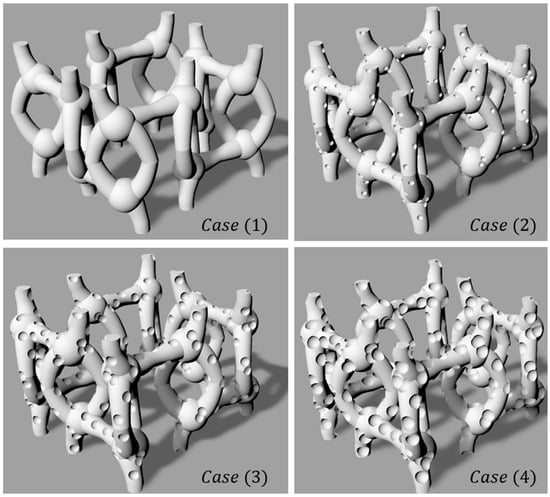
Figure 16.
Four cases of surface refinement in order to evaluate the complexity index.
After the surface refinement with spherical objects was applied to all four cases, the following geometrical parameters were derived: total surface area , bottom projection area , complexity index , as well as total structure volume. The “ difference” and “volume difference” rows provide the difference of results between the reference case (case 1) and each of the other surface refinement variations (cases 2 to 4), respectively. Obtained results of SI calculation and total MFAR volume are summarized in Table 3. The “ difference” and “Volume difference” rows provide the difference of results between the case 1 and cases 2 to 4, respectively.

Table 3.
Complexity index and mass calculation for the proposed MFAR.
The results shown in Table 2 suggest that, by using the parametric design and applying a relatively simple surface refinement on the initial MFAR, the outcome can lead to a significant increase in SI values, reaching up to a 21.6% difference for case 4 when compared to the reference design (case 1). As demonstrated by [93], the SI tends to be linearly proportional to the wake volume created behind the MFAR in the water flow for ARs with a rectangular shape and, in this case, with oyster shells on the top part. Thus, it is assumed that for cases 1 to 4 there is an increase in the wake volume that is proportional to the total surface area, therefore somewhat proportionally promoting positive effects on fisheries and biodiversity restoration MFAR functions.
Finally, the total volume was calculated and by applying the very coarse surface refinement of case 4, a difference of 26.7% was achieved when comparing to the reference case 1. Taking this into account, case 4 may be considered as the solution that occupies the largest space with the least total volume of manufacturing material required to create a single MFAR, which represents less than 1/4 compared to the reference design (case 1) and may lead to more sustainable designs when considering such surface refinement.
4. Conclusions
This research proposed a novel approach to the design of modular MFAR involving parametric design with visual programming tools. Such an approach is proposed for application to parametrically designed modular multi-functional artificial reefs assembled from separate and equal or similar modular parts in various planes and angles in relation to each other in order to arrange the whole structure. The parametric design approach is based on a set of parameters that determine the surface and geometry features of the MFAR and make it particularly interesting for further studies oriented to the definition of optimal parameters considering technical, economic, environmental, and biological design requirements.
This method supports the creation of geometrically complex, multifunctional marine structures, offering new possibilities for biomimetic designs with multiple levels of structural complexity. The modular construction approach enables the building of large, intricate structures from a small number of well-designed units. Parametric design enhances modularity by simulating various arrangements and their effects, making it easier to test and optimize different configurations.
Moreover, the integrated design framework seamlessly combines various design aspects, including structural, hydrodynamic and mechanical design, as well as virtual simulations and ecosystem interactions. This comprehensive approach ensures that the design process is holistic, considering all scales from individual units to macro-structures, and aligns with fabrication and assembly procedures based on a virtual model.
The application to a location in the north Atlantic of Portugal allowed matching the design to the specific deployment location and requirements, considering species conservation, bathymetry, and recreational needs. This method allowed for directly linking the specific ecological functions of MFAR with engineering variables, leading to more effective and sustainable artificial reef solutions for marine conservation and coastal management. It was also shown that surface refinements in the form of randomly sized nested cavities can be incorporated, aiming at the restoration of specific marine species. In this case, the structural complexity index increased up to 21.6% and decreased the use of structural material down to 26.7% compared to the reference design. As a result, a framework where the design parameters were directly related to the MFAR target functions was developed, providing a first step in such a direction. This example shows the potential of computational algorithms and generative processes for MFAR innovative and purpose-oriented design. This allows future studies to directly link MFAR performance to design parameters, paving the way for fully engineered, performance-based MFAR designs, including integrated sensing systems introduced on the design stage. Systematic field studies are needed to validate the design approaches investigated, where the design variables may be studied separately and directly related to performance indicators of the MFAR. The potential of computational algorithms and generative processes for MFAR can be further enhanced by complicating the parametric design to include natural complexity.
Author Contributions
Conceptualization, D.M., E.P., T.M. and F.C.; methodology, D.M. and E.P.; software, D.M.; validation, D.M.; formal analysis, D.M. and E.P.; resources, E.P., T.M., I.B.V. and M.P.; data curation, D.M., E.P. and F.C.; writing—original draft preparation, D.M. and E.P.; writing—review and editing, E.P., T.M., I.B.V., V.F. and M.P.; visualization, D.M. and F.C.; supervision, E.P., T.M., V.F. and I.B.V.; project administration, E.P., T.M., V.F. and I.B.V.; funding acquisition, E.P., T.M. and I.B.V. All authors have read and agreed to the published version of the manuscript.
Funding
The authors gratefully acknowledge funding from the FEDER funds in the scope of the project “NEXT-SEA: Next Generation Monitoring of Coastal Systems in a Scenario of Global Change”, with reference NORTE-01-0145-FEDER-000032. The first and fifth authors wish also to acknowledge the PhD grants SFRH/BD/129583/2017 and SFRH/BD/137220/2018, respectively, provided by the National Science Foundation (FCT), Portugal.
Institutional Review Board Statement
Not applicable.
Informed Consent Statement
Not applicable.
Data Availability Statement
The original contributions presented in the study are included in the article, further inquiries can be directed to the corresponding author.
Acknowledgments
The authors thank the University of Minho for support.
Conflicts of Interest
The authors declare that they have no known competing financial interests or personal relationships that could have appeared to influence the work reported in this paper.
References
- Bortone, S.A. A Perspective of Artificial Reef Research: The Past, Present, and Future. Bull. Mar. Sci. 2006, 78, 1–8. [Google Scholar]
- Lima, J.S.; Zalmon, I.R.; Love, M. Overview and Trends of Ecological and Socioeconomic Research on Artificial Reefs. Mar. Environ. Res. 2019, 145, 81–96. [Google Scholar] [CrossRef] [PubMed]
- Lee, M.O.; Otake, S.; Kim, J.K. Transition of Artificial Reefs (ARs) Research and Its Prospects. Ocean. Coast. Manag. 2018, 154, 55–65. [Google Scholar] [CrossRef]
- Bohnsack, J.A.; Sutherland, D.L. Artificial Reef Research: A Review with Recommendations for Future Priorities. Bull. Mar. Sci. 1985, 37, 11–39. [Google Scholar]
- Fabi, G.; Spagnolo, A.; Bellan-Santini, D.; Charbonnel, E.; Çiçek, B.A.; García, J.J.G.; Jensen, A.C.; Kallianiotis, A.; dos Santos, M.N. Overview on Artificial Reefs in Europe. Braz. J. Oceanogr. 2011, 59, 155–166. [Google Scholar] [CrossRef]
- Santos, M.N.; Monteiro, C.C. The Olhao Artificial Reef System (South Portugal): Fish Assemblages and Fishing Yield. Fish. Res. 1997, 30, 33–41. [Google Scholar] [CrossRef]
- Charbonnel, E.; Bachet, F. Artificial Reefs in the Cote Bleue Marine Park: Assessment after 25 Years of Experiments and Scientific Monitoring. In Global Change: Mankind-Marine Environment Interactions; Springer: Dordrecht, The Netherlands, 2010; pp. 73–79. [Google Scholar]
- Toledo, M.I.; Torres, P.; Díaz, C.; Zamora, V.; López, J.; Olivares, G. Ecological Succession of Benthic Organisms on Niche-Type Artificial Reefs. Ecol. Process 2020, 9, 38. [Google Scholar] [CrossRef]
- Goreau, T.; Prong, P. Biorock Electric Reefs Grow Back Severely Eroded Beaches in Months. J. Mar. Sci. Eng. 2017, 5, 48. [Google Scholar] [CrossRef]
- Hong, S.; Choi, Y.; Kim, T.; Lee, G.S.; Hur, D.S.; Kwon, S. The Enhanced Mitigation of Coastal Erosion Using the Artificial Coral Reefs. J. Coast. Res. 2019, 91, 11–15. [Google Scholar] [CrossRef]
- Kim, I.; Kim, J.; Nam, J.; Song, D.; Lee, H. Changes in the Behavioral Characteristics of the Gangmun and Anmok Beaches Following the Construction of Artificial Reefs. J. Coast. Res. 2019, 91, 26–30. [Google Scholar] [CrossRef]
- Flanigan, C.; Marrin, D.L. Sculpture and Coral Reefs: Combining Art, Research, Tourism and Education. ESS Open Arch. 2020. [Google Scholar] [CrossRef]
- Belhassen, Y.; Rousseau, M.; Tynyakov, J.; Shashar, N. Evaluating the Attractiveness and Effectiveness of Artificial Coral Reefs as a Recreational Ecosystem Service. J. Environ. Manag. 2017, 203, 448–456. [Google Scholar] [CrossRef]
- Fletcher, S.; Bateman, P.; Emery, A. The Governance of the Boscombe Artificial Surf Reef, UK. Land Use Policy 2011, 28, 395–401. [Google Scholar] [CrossRef]
- Do Carmo, J.S.A.; Ten Voorde, M.; Neves, M.G. Enhancing Submerged Coastal Constructions by Incorporating Multifunctional Purposes. J. Coast. Conserv. 2011, 15, 531–546. [Google Scholar] [CrossRef]
- Mead, S.T.; Blenkinsopp, C.; Moores, A.; Borrero, J. Design and Construction of the Boscombe Multi-Purpose Reef. Coast. Eng. Proc. 2011, 1, 58. [Google Scholar] [CrossRef]
- Mendonça, A.; Fortes, C.J.; Capitão, R.; da Graça Neves, M.; Moura, T.; Do Carmo, J.S.A. Wave Hydrodynamics around a Multi-Functional Artificial Reef at Leirosa. J. Coast. Conserv. 2012, 16, 543–553. [Google Scholar] [CrossRef]
- Evans, A.J.; Garrod, B.; Firth, L.B.; Hawkins, S.J.; Morris-Webb, E.S.; Goudge, H.; Moore, P.J.M. Stakeholder Priorities for Multi-Functional Coastal Defence Developments and Steps to Effective Implementation. Mar. Policy 2017, 75, 143–155. [Google Scholar] [CrossRef]
- López, I.; Tinoco, H.; Aragonés, L.; Garcia-Barba, J. The Multifunctional Artificial Reef and Its Role in the Defence of the Mediterranean Coast. Sci. Total Environ. 2016, 550, 910–923. [Google Scholar] [CrossRef] [PubMed]
- Edwards, P.E.T.; Sutton-Grier, A.E.; Coyle, G.E. Investing in Nature: Restoring Coastal Habitat Blue Infrastructure and Green Job Creation. Mar. Policy 2013, 38, 65–71. [Google Scholar] [CrossRef]
- Arkema, K.K.; Griffin, R.; Maldonado, S.; Silver, J.; Suckale, J.; Guerry, A.D. Linking Social, Ecological, and Physical Science to Advance Natural and Nature-based Protection for Coastal Communities. Ann. N. Y. Acad. Sci. 2017, 1399, 5–26. [Google Scholar] [CrossRef] [PubMed]
- Palinkas, C.M.; Orton, P.; Hummel, M.A.; Nardin, W.; Sutton-Grier, A.E.; Harris, L.; Gray, M.; Li, M.; Ball, D.; Burks-Copes, K.; et al. Innovations in Coastline Management With Natural and Nature-Based Features (NNBF): Lessons Learned From Three Case Studies. Front. Built Environ. 2022, 8, 814180. [Google Scholar] [CrossRef]
- Schoonees, T.; Mancheño, A.G.; Scheres, B.; Bouma, T.J.; Silva, R.; Schlurmann, T.; Schüttrumpf, H. Hard Structures for Coastal Protection, Towards Greener Designs. Estuaries Coasts 2019, 42, 1709–1729. [Google Scholar] [CrossRef]
- de Vriend, H.J.; van Koningsveld, M.; Aarninkhof, S.G.J.; de Vries, M.B.; Baptist, M.J. Sustainable Hydraulic Engineering through Building with Nature. J. Hydro-Environ. Res. 2015, 9, 159–171. [Google Scholar] [CrossRef]
- Morris, R.L.; Konlechner, T.M.; Ghisalberti, M.; Swearer, S.E. From Grey to Green: Efficacy of Eco-Engineering Solutions for Nature-Based Coastal Defence. Glob. Chang. Biol. 2018, 24, 1827–1842. [Google Scholar] [CrossRef]
- Nesshöver, C.; Assmuth, T.; Irvine, K.N.; Rusch, G.M.; Waylen, K.A.; Delbaere, B.; Haase, D.; Jones-Walters, L.; Keune, H.; Kovacs, E.; et al. The Science, Policy and Practice of Nature-Based Solutions: An Interdisciplinary Perspective. Sci. Total Environ. 2017, 579, 1215–1227. [Google Scholar] [CrossRef]
- Moschella, P.S.; Abbiati, M.; Åberg, P.; Airoldi, L.; Anderson, J.M.; Bacchiocchi, F.; Bulleri, F.; Dinesen, G.E.; Frost, M.; Gacia, E.; et al. Low-Crested Coastal Defence Structures as Artificial Habitats for Marine Life: Using Ecological Criteria in Design. Coast. Eng. 2005, 52, 1053–1071. [Google Scholar] [CrossRef]
- Chapman, M.G.; Underwood, A.J. Evaluation of Ecological Engineering of “Armoured” Shorelines to Improve Their Value as Habitat. J. Exp. Mar. Biol. Ecol. 2011, 400, 302–313. [Google Scholar] [CrossRef]
- Narayan, S.; Beck, M.W.; Reguero, B.G.; Losada, I.J.; Van Wesenbeeck, B.; Pontee, N.; Sanchirico, J.N.; Ingram, J.C.; Lange, G.M.; Burks-Copes, K.A. The Effectiveness, Costs and Coastal Protection Benefits of Natural and Nature-Based Defences. PLoS ONE 2016, 11, e0154735. [Google Scholar] [CrossRef]
- Komyakova, V.; Jaffrés, J.B.D.; Strain, E.M.A.; Cullen-Knox, C.; Fudge, M.; Langhamer, O.; Bender, A.; Yaakub, S.M.; Wilson, E.; Allan, B.J.M.; et al. Conceptualisation of Multiple Impacts Interacting in the Marine Environment Using Marine Infrastructure as an Example. Sci. Total Environ. 2022, 830, 154748. [Google Scholar] [CrossRef]
- Fonseca, M.S.; Cahalan, J.A. A Preliminary Evaluation of Wave Attenuation by Four Species of Seagrass. Estuar. Coast. Shelf Sci. 1992, 35, 565–576. [Google Scholar] [CrossRef]
- Bradley, K.; Houser, C. Relative Velocity of Seagrass Blades: Implications for Wave Attenuation in Low-Energy Environments. J. Geophys. Res. Earth Surf. 2009, 114. [Google Scholar] [CrossRef]
- Coombes, M.A.; La Marca, E.C.; Naylor, L.A.; Thompson, R.C. Getting into the Groove: Opportunities to Enhance the Ecological Value of Hard Coastal Infrastructure Using Fine-Scale Surface Textures. Ecol. Eng. 2015, 77, 314–323. [Google Scholar] [CrossRef]
- Firth, L.B.; Thompson, R.C.; Bohn, K.; Abbiati, M.; Airoldi, L.; Bouma, T.J.; Bozzeda, F.; Ceccherelli, V.U.; Colangelo, M.A.; Evans, A.; et al. Between a Rock and a Hard Place: Environmental and Engineering Considerations When Designing Coastal Defence Structures. Coast. Eng. 2014, 87, 122–135. [Google Scholar] [CrossRef]
- Jackson, A.; Tomlinson, R.; Corbett, B.; Strauss, D. Long Term Performance of a Submerged Coastal Control Structure: A Case Study of the Narrowneck Multi-Functional Artificial Reef. Coast. Eng. Proc. 2012, 1, 54. [Google Scholar] [CrossRef]
- Ng, K.; Thomas, T.; Phillips, M.R.; Calado, H.; Borges, P.; Veloso-Gomes, F. Multifunctional Artificial Reefs for Small Islands: An Evaluation of Amenity and Opportunity for Sao Miguel Island, the Azores. Prog. Phys. Geogr. 2015, 39, 220–257. [Google Scholar] [CrossRef]
- MARS-Modular Artificial Reef Structure. Available online: https://www.reefdesignlab.com/ (accessed on 15 February 2024).
- Engler, E. Modular Artificial Reef Sea Wall and Marine Habitat. US Patent 6,896,445B1, 24 May 2005. [Google Scholar]
- Pinheiro, M.; Marisa, T.; Pereira, E.; Valente, I.; Cruz, F.; Maslov, D. Application of Geostatistical Techniques to Support Data Acquisition and Predict Maritime Variables. In Proceedings of the OCEANS 2018 MTS/IEEE Charleston, OCEAN 2018, North Charleston, SC, USA, 22–25 October 2018. [Google Scholar]
- Pinheiro, M.; Miranda, T.; Ferreira, V.; Pereira, E.; Valente, I.; Cruz, F.; Maslov, D. From Decision-Making to Oceans Accounts: A Case Study. In Proceedings of the OCEANS 2019—Marseille, Marseille, France, 17–20 June 2019; pp. 1–6. [Google Scholar]
- James, B.G. Exploring the Emerging Design Territory of Construction 3D Printing—Project Led Architectural Research. Ph.D. Thesis, RMIT University, Melbourne, Australia, 2011. [Google Scholar]
- Mendoza, E.; Ríos, A.; Mariño-Tapia, I.; Silva, R. Modular Coral Shaped Artificial Reefs Acting as Beach Protection Barriers. In Coastal Structures; Bundesanstalt für Wasserbau: Karlsruhe, Germany, 2019. [Google Scholar] [CrossRef]
- Nakamura, M. Evolution of Artificial Fishing Reef Concepts in Japan. Bull. Mar. Sci. 1985, 37, 271–278. [Google Scholar]
- Spanier, E.; Lavalli, L.; Edelist, D. Artificial Habitats for Benthic Dwelling Lobsters-Analysis of 5 Decades of Research. J. Mar. Biol. Assoc. India 2010, 52, 113–138. [Google Scholar]
- Lipcius, R.N.; Burke, R.P. Abundance, Biomass and Size Structure of Eastern Oyster and Hooked Mussel on a Modular Artificial Reef in the Rappahannock River, Chesapeake Bay; Virginia Institute of Marine Science, College of William and Mary: Gloucester Point, VA, USA, 2006. [Google Scholar]
- Hensel, E.; Allgeier, J.E.; Layman, C.A. Effects of Predator Presence and Habitat Complexity on Reef Fish Communities in The Bahamas. Mar. Biol. 2019, 166, 136. [Google Scholar] [CrossRef]
- Fitzhardinge, R.C.; Bailey-Brock, J.H. Colonization of Artificial Reef Materials by Corals and Other Sessile Organisms. Bull. Mar. Sci. 1989, 44, 567–579. [Google Scholar]
- Oren, U.; Benayahu, Y. Transplantation of Juvenile Corals: A New Approach for Enhancing Colonization of Artificial Reefs. Mar. Biol. 1997, 127, 499–505. [Google Scholar] [CrossRef]
- Warren, D.J.; Warren, D.T. Integrated Reef Building System. US Patent 5,803,660, 8 September 1998. [Google Scholar]
- Sutton-Grier, A.E.; Wowk, K.; Bamford, H. Future of Our Coasts: The Potential for Natural and Hybrid Infrastructure to Enhance the Resilience of Our Coastal Communities, Economies and Ecosystems. Environ. Sci. Policy 2015, 51, 137–148. [Google Scholar] [CrossRef]
- Ng, K.; Phillips, M.R.; Calado, H.; Borges, P.; Veloso-Gomes, F. Seeking Harmony in Coastal Development for Small Islands: Exploring Multifunctional Artificial Reefs for São Miguel Island, the Azores. Appl. Geogr. 2013, 44, 99–111. [Google Scholar] [CrossRef]
- Lawson, C.R. Geotextiles in Marine Engineering. In Geotextiles: From Design to Applications; Woodhead Publishing: Cambridge, UK, 2016; pp. 435–482. [Google Scholar] [CrossRef]
- Kirkbride-Smith, A.E.; Wheeler, P.M.; Johnson, M.L. The Relationship between Diver Experience Levels and Perceptions of Attractiveness of Artificial Reefs-Examination of a Potential Management Tool. PLoS ONE 2013, 8, e68899. [Google Scholar] [CrossRef] [PubMed]
- Encarnação, J.; Calado, G. Effects of Recreational Diving on Early Colonization Stages of an Artificial Reef in North-East Atlantic. J. Coast. Conserv. 2018, 22, 1209–1216. [Google Scholar] [CrossRef]
- Dowling, R.K.; Nichol, J. The HMAS Swan Artificial Diving Reef. Ann. Tour. Res. 2001, 28, 226–229. [Google Scholar] [CrossRef]
- Taylor, J.C.; McCormick, C.; Scales, H. The Underwater Museum: The Submerged Sculptures of Jason DeCaires Taylor; Chronicle Books: San Francisco, CA, USA, 2014. [Google Scholar]
- Spence, H.R. Bioacoustic Monitoring Station in Underwater Sculpture. J. Acoust. Soc. Am. 2017, 141, 3947. [Google Scholar] [CrossRef]
- Nagel, J.; Schmidt, L.; Born, W. Establishing Analogy Categories for Bio-Inspired Design. Designs 2018, 2, 47. [Google Scholar] [CrossRef]
- Perkol-Finkel, S.; Shashar, N.; Benayahu, Y. Can Artificial Reefs Mimic Natural Reef Communities? The Roles of Structural Features and Age. Mar. Environ. Res. 2006, 61, 121–135. [Google Scholar] [CrossRef]
- Berman, O.; Weizman, M.; Oren, A.; Neri, R.; Parnas, H.; Shashar, N.; Tarazi, E. Design and Application of a Novel 3D Printing Method for Bio-Inspired Artificial Reefs. Ecol. Eng. 2023, 188, 106892. [Google Scholar] [CrossRef]
- Chou, L.M. Artificial Reefs of Southeast Asia—Do They Enhance or Degrade the Marine Environment? Environ. Monit. Assess. 1997, 44, 45–52. [Google Scholar] [CrossRef]
- Kaiser, M.J. The Louisiana Artificial Reef Program. Mar. Policy 2006, 30, 605–623. [Google Scholar] [CrossRef]
- Campos, J.A.; Gamboa, C. An Artificial Tire-Reef in a Tropical Marine System: A Management Tool. Bull. Mar. Sci. 1989, 44, 757–766. [Google Scholar]
- Patterson, W.F.; Cowan, J.; Wilson, C.A.; Shipp, R.L. Age and Growth of Red Snapper, Lutjanus Campechanus, from an Artificial Reef Area off Alabama in the Northern Gulf of Mexico. Fish. Bull. 2001, 99, 617–627. [Google Scholar]
- Holzer, D.; Tang, J.; Xie, Y.; Burry, M. Evolutionary Structural Optimisation and Parametric Design in Transdisciplinary Collaboration. In Innovations in Structural Engineering and Construction; Taylor and Francis: Boca Raton, FL, USA, 2008; pp. 851–856. [Google Scholar]
- Mohammed, J.S. Applications of 3D Printing Technologies in Oceanography. Methods Oceanogr. 2016, 17, 97–117. [Google Scholar] [CrossRef]
- Berman, O.; Levy, N.; Parnas, H.; Levy, O.; Tarazi, E. Exploring New Frontiers in Coral Nurseries: Leveraging 3D Printing Technology to Benefit Coral Growth and Survival. J. Mar. Sci. Eng. 2023, 11, 1695. [Google Scholar] [CrossRef]
- Carr, M.H.; Hixon, M.A. Artificial Reefs: The Importance of Comparisons with Natural Reefs. Fisheries 1997, 22, 28–33. [Google Scholar] [CrossRef]
- Lemoine, H.R.; Paxton, A.B.; Anisfeld, S.C.; Rosemond, R.C.; Peterson, C.H. Selecting the Optimal Artificial Reefs to Achieve Fish Habitat Enhancement Goals. Biol. Conserv. 2019, 238, 108200. [Google Scholar] [CrossRef]
- Zavoleas, Y.; Haeusler, M. Extended Modelling-Dynamic Approaches Applied to Design Reef Habitats at Sydney Harbour. In ShoCK!—Sharing Computational Knowledge!—Proceedings of the 35th eCAADe Conference, Rome, Italy, 20–22 September 2017; eCAADe (Education and Research in Computer Aided Architectural Design in Europe) and Dep. of Civil, Building and Environmental Engineering, Faculty of Civil and Industrial Engineering, Sapienza University of Rome: Rome, Italy, 2017; pp. 67–74. [Google Scholar] [CrossRef]
- Whalan, S.; Abdul Wahab, M.A.; Sprungala, S.; Poole, A.J.; de Nys, R. Larval Settlement: The Role of Surface Topography for Sessile Coral Reef Invertebrates. PLoS ONE 2015, 10, e0117675. [Google Scholar] [CrossRef]
- Levenstein, M.A.; Gysbers, D.J.; Marhaver, K.L.; Kattom, S.; Tichy, L.; Quinlan, Z.; Tholen, H.M.; Wegley Kelly, L.; Vermeij, M.J.A.; Wagoner Johnson, A.J.; et al. Millimeter-Scale Topography Facilitates Coral Larval Settlement in Wave-Driven Oscillatory Flow. PLoS ONE 2022, 17, e0274088. [Google Scholar] [CrossRef]
- Kupfner Johnson, S.; Hallock, P. A Review of Symbiotic Gorgonian Research in the Western Atlantic and Caribbean with Recommendations for Future Work. Coral Reefs 2020, 39, 239–258. [Google Scholar] [CrossRef]
- Panero, M.; Galbraith, G.F.; Srinivasan, M.; Jones, G.P. Roles of Depth, Current Speed, and Benthic Cover in Shaping Gorgonian Assemblages at the Palm Islands (Great Barrier Reef). Coral Reefs 2023, 42, 1045–1057. [Google Scholar] [CrossRef]
- May, P.; Mendy, G.; Tallett, P. Structural Integrity Monitoring: Review and Appraisal of Current Technologies for Offshore Applications; Atkins Limited: Epsom, UK, 2009. [Google Scholar]
- Wang, P.; Tian, X.; Peng, T.; Luo, Y. A Review of the State-of-the-Art Developments in the Field Monitoring of Offshore Structures. Ocean Eng. 2018, 147, 148–164. [Google Scholar] [CrossRef]
- Maslov, D.; Pereira, E.; Miranda, T.; Valente, M.; Cruz, F.; Pinheiro, M. Innovative Monitoring Strategies for Multifunctional Artificial Reefs. In Proceedings of the OCEANS 2018 MTS/IEEE Charleston, OCEAN 2018, North Charleston, SC, USA, 22–25 October 2018. [Google Scholar]
- Shani, A.; Polak, O.; Shashar, N. Artificial Reefs and Mass Marine Ecotourism. Tour. Geogr. 2012, 14, 361–382. [Google Scholar] [CrossRef]
- Beeby, S.P.; Tudor, M.J.; White, N.M. Energy Harvesting Vibration Sources for Microsystems Applications. Meas. Sci. Technol. 2006, 17, R175. [Google Scholar] [CrossRef]
- Li, H.; Tian, C.; Deng, Z.D. Energy Harvesting from Low Frequency Applications Using Piezoelectric Materials. Appl. Phys. Rev. 2014, 1, 41301. [Google Scholar] [CrossRef]
- Maslov, D.; Johnson, J.; Pereira, E.; Duarte, D.; Miranda, T.; Lima, M.; Cruz, F.; Valente, I.; Pinheiro, M. Experimental Testing and CFD Modelling for Prototype Design of Innovative Artificial Reef Structures. In Proceedings of the OCEANS 2019—Marseille, Marseille, France, 17–20 June 2019; pp. 1–7. [Google Scholar]
- Cruz, F.; Pereira, E.; Lima, M.; Johnson, J.; Duarte, D.; Valente, I.B.; Miranda, T.; Maslov, D.; Pinheiro, M. Experimental Characterization of the Scour of Innovative Artificial Reef Prototypes Using Hydraulic Flume and Photogrammetry. In Proceedings of the OCEANS 2019—Marseille, Marseille, France, 17–20 June 2019. [Google Scholar]
- Fabio, C.; Eduardo, P.; Valente, I.B.; Tiago, M.; Maslov, D.; Pinheiro, M. Structural Design of an Innovative Multifunctional Artificial Reef. In Proceedings of the OCEANS 2018 MTS/IEEE Charleston, OCEAN 2018, North Charleston, SC, USA, 22–25 October 2018. [Google Scholar]
- Frazer, T.K.; Lindberg, W.J. Refuge Spacing Similarly Affects Reef-Associated Species from Three Phyla. Bull. Mar. Sci. 1994, 55, 388–400. [Google Scholar]
- Langhamer, O.; Wilhelmsson, D. Colonisation of Fish and Crabs of Wave Energy Foundations and the Effects of Manufactured Holes—A Field Experiment. Mar. Environ. Res. 2009, 68, 151–157. [Google Scholar] [CrossRef]
- Kim, C.G.; Lee, J.W.; Park, J.S. Artificial Reef Designs for Korean Coastal Waters. Bull. Mar. Sci. 1994, 55, 858–866. [Google Scholar]
- Maslov, D.; Pereira, E.; Duarte, D.; Miranda, T.; Ferreira, V.; Tieppo, M.; Cruz, F.; Johnson, J. Numerical Analysis of the Flow Field and Cross Section Design Implications in a Multifunctional Artificial Reef. Ocean Eng. 2023, 272, 113817. [Google Scholar] [CrossRef]
- Saleh, E.; Geng, C.N.; Kiat, Y.T.; Isnain, I. Effect of Artificial Structures on Shoreline Profile of Selingan Island, Sandakan, Sabah, Malaysia. Borneo J. Mar. Sci. Aquac. BJoMSA 2018, 2, 9–15. [Google Scholar] [CrossRef]
- Stolk, P.; Markwell, K.; Jenkins, J. Perceptions of Artificial Reefs as Scuba Diving Resources: A Study of Australian Recreational Scuba Divers. Ann. Leis. Res. 2013, 8, 153–166. [Google Scholar] [CrossRef]
- Stolk, P.; Markwell, K.; Jenkins, J.M. Artificial Reefs as Recreational Scuba Diving Resources: A Critical Review of Research. J. Sustain. Tour. 2009, 15, 331–350. [Google Scholar] [CrossRef]
- Kim, D.; Woo, J.; Yoon, H.S.; Na, W.B. Efficiency, Tranquillity and Stability Indices to Evaluate Performance in the Artificial Reef Wake Region. Ocean Eng. 2016, 122, 253–261. [Google Scholar] [CrossRef]
- Lee, I.-C.; Kim, D.; Jung, S.; Na, W.-B. Prediction of Primary Physical Measures for Cost-Effective Management of Artificial Seaweed Reefs. Mar. Technol. Soc. J. 2020, 54, 25–43. [Google Scholar] [CrossRef]
- Kim, M.; Jung, S.; Van Chau, T.; Na, W.-B. Correlation of the Structural Characteristics of an Artificial Oyster Reef with Its Wake Region. J. Mar. Sci. Eng. 2023, 11, 775. [Google Scholar] [CrossRef]
- Jung, S.; Na, W.-B.; Kim, D. Rugosity and Blocking Indices of Artificial Reefs and Their Correlations with Wake Volume. Ocean Eng. 2022, 261, 112204. [Google Scholar] [CrossRef]
- Vivier, B.; Dauvin, J.C.; Navon, M.; Rusig, A.M.; Mussio, I.; Orvain, F.; Boutouil, M.; Claquin, P. Marine Artificial Reefs, a Meta-Analysis of Their Design, Objectives and Effectiveness. Glob. Ecol. Conserv. 2021, 27, e01538. [Google Scholar] [CrossRef]
- Carral, L.; Lamas, M.I.; Cartelle Barros, J.J.; López, I.; Carballo, R. Proposed Conceptual Framework to Design Artificial Reefs Based on Particular Ecosystem Ecology Traits. Biology 2022, 11, 680. [Google Scholar] [CrossRef]
Disclaimer/Publisher’s Note: The statements, opinions and data contained in all publications are solely those of the individual author(s) and contributor(s) and not of MDPI and/or the editor(s). MDPI and/or the editor(s) disclaim responsibility for any injury to people or property resulting from any ideas, methods, instructions or products referred to in the content. |
© 2024 by the authors. Licensee MDPI, Basel, Switzerland. This article is an open access article distributed under the terms and conditions of the Creative Commons Attribution (CC BY) license (https://creativecommons.org/licenses/by/4.0/).